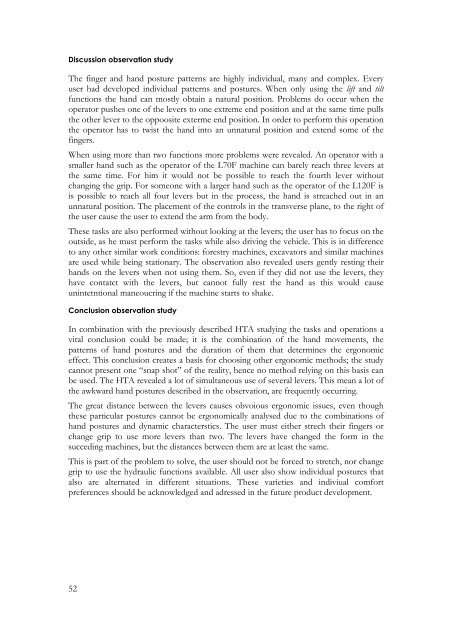Design of an ergonomic control lever for wheel loader attachments
Design of an ergonomic control lever for wheel loader attachments
Design of an ergonomic control lever for wheel loader attachments
You also want an ePaper? Increase the reach of your titles
YUMPU automatically turns print PDFs into web optimized ePapers that Google loves.
Discussion observation study<br />
The finger <strong>an</strong>d h<strong>an</strong>d posture patterns are highly individual, m<strong>an</strong>y <strong>an</strong>d complex. Every<br />
user had developed individual patterns <strong>an</strong>d postures. When only using the lift <strong>an</strong>d tilt<br />
functions the h<strong>an</strong>d c<strong>an</strong> mostly obtain a natural position. Problems do occur when the<br />
operator pushes one <strong>of</strong> the <strong>lever</strong>s to one extreme end position <strong>an</strong>d at the same time pulls<br />
the other <strong>lever</strong> to the oppoosite exterme end position. In order to per<strong>for</strong>m this operation<br />
the operator has to twist the h<strong>an</strong>d into <strong>an</strong> unnatural position <strong>an</strong>d extend some <strong>of</strong> the<br />
fingers.<br />
When using more th<strong>an</strong> two functions more problems were revealed. An operator with a<br />
smaller h<strong>an</strong>d such as the operator <strong>of</strong> the L70F machine c<strong>an</strong> barely reach three <strong>lever</strong>s at<br />
the same time. For him it would not be possible to reach the fourth <strong>lever</strong> without<br />
ch<strong>an</strong>ging the grip. For someone with a larger h<strong>an</strong>d such as the operator <strong>of</strong> the L120F is<br />
is possible to reach all four <strong>lever</strong>s but in the process, the h<strong>an</strong>d is streached out in <strong>an</strong><br />
unnatural position. The placement <strong>of</strong> the <strong>control</strong>s in the tr<strong>an</strong>sverse pl<strong>an</strong>e, to the right <strong>of</strong><br />
the user cause the user to extend the arm from the body.<br />
These tasks are also per<strong>for</strong>med without looking at the <strong>lever</strong>s; the user has to focus on the<br />
outside, as he must per<strong>for</strong>m the tasks while also driving the vehicle. This is in difference<br />
to <strong>an</strong>y other similar work conditions: <strong>for</strong>estry machines, excavators <strong>an</strong>d similar machines<br />
are used while being stationary. The observation also revealed users gently resting their<br />
h<strong>an</strong>ds on the <strong>lever</strong>s when not using them. So, even if they did not use the <strong>lever</strong>s, they<br />
have contatct with the <strong>lever</strong>s, but c<strong>an</strong>not fully rest the h<strong>an</strong>d as this would cause<br />
unintetntional m<strong>an</strong>eoucring if the machine starts to shake.<br />
Conclusion observation study<br />
In combination with the previously described HTA studying the tasks <strong>an</strong>d operations a<br />
vital conclusion could be made; it is the combination <strong>of</strong> the h<strong>an</strong>d movements, the<br />
patterns <strong>of</strong> h<strong>an</strong>d postures <strong>an</strong>d the duration <strong>of</strong> them that determines the <strong>ergonomic</strong><br />
effect. This conclusion creates a basis <strong>for</strong> choosing other <strong>ergonomic</strong> methods; the study<br />
c<strong>an</strong>not present one “snap shot” <strong>of</strong> the reality, hence no method relying on this basis c<strong>an</strong><br />
be used. The HTA revealed a lot <strong>of</strong> simult<strong>an</strong>eous use <strong>of</strong> several <strong>lever</strong>s. This me<strong>an</strong> a lot <strong>of</strong><br />
the awkward h<strong>an</strong>d postures described in the observation, are frequently occurring.<br />
The great dist<strong>an</strong>ce between the <strong>lever</strong>s causes obvoious <strong>ergonomic</strong> issues, even though<br />
these particular postures c<strong>an</strong>not be <strong>ergonomic</strong>ally <strong>an</strong>alysed due to the combinations <strong>of</strong><br />
h<strong>an</strong>d postures <strong>an</strong>d dynamic characterstics. The user must either strech their fingers or<br />
ch<strong>an</strong>ge grip to use more <strong>lever</strong>s th<strong>an</strong> two. The <strong>lever</strong>s have ch<strong>an</strong>ged the <strong>for</strong>m in the<br />
succeding machines, but the dist<strong>an</strong>ces between them are at least the same.<br />
This is part <strong>of</strong> the problem to solve, the user should not be <strong>for</strong>ced to stretch, nor ch<strong>an</strong>ge<br />
grip to use the hydraulic functions available. All user also show individual postures that<br />
also are alternated in different situations. These varieties <strong>an</strong>d indiviual com<strong>for</strong>t<br />
preferences should be acknowledged <strong>an</strong>d adressed in the future product development.<br />
52
















